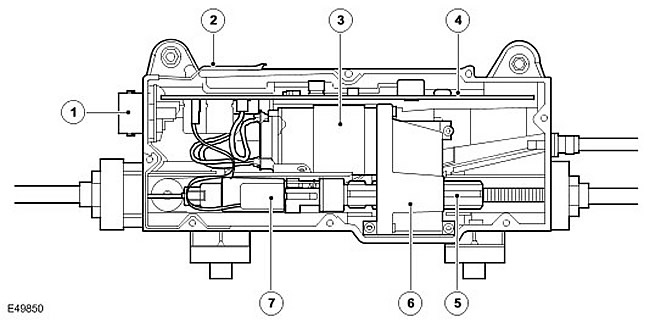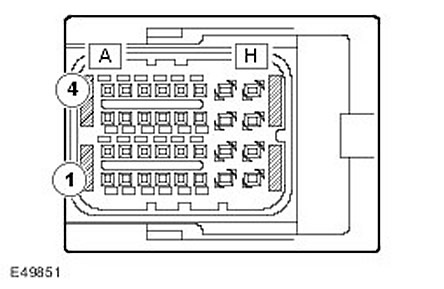The parking brake control unit is mounted on a support bracket attached to the front of the spare wheel bracket. Two rubber mounts mounted on brackets on the bottom of the parking brake control box fit into the holes in the support bracket. The top corners of the parking brake control box are attached to the support bracket with rubber mounts and flange nuts.
The main components and parts of the parking brake control unit:
- PCB with ASIC (specialized integrated circuit), to control the parking brake.
- Electric motor.
- Reducer.
- Splined shaft.
- Force sensor.
The splined shaft and force sensor are connected by a retainer at the end of the splined shaft. The spline shaft rotates on a detent and moves axially in the gearbox. The retainer and the force sensor move in the channel of the housing of the parking brake control unit.
To engage and disengage the drum brakes, the parking brake control unit activates an electric motor that drives the gearbox. The gearbox turns the splined shaft, increasing or decreasing the tension of the brake cables. The parking brake control unit controls the load applied to the brake cables based on the force sensor signal.
Internal structure of the parking brake control unit

| Item name | Spare part number | Description |
| 1 | electrical connector | |
| 2 | Frame | |
| 3 | electric motor | |
| 4 | Printed circuit board | |
| 5 | splined shaft | |
| 6 | Reducer | |
| 7 | force sensor |
Inputs and outputs
With R.H (right) A 32-pin connector is installed on the side of the parking brake control unit, which connects the printed circuit board to the vehicle's electrical wiring.
Power is supplied to the parking brake control unit via two permanent lines from the BJB (battery electrical junction box). Two other connections to CJB (central electrical box) designed to transmit voltage signals when the key is inserted in the ignition and when the key is in position II (ignition on). The other permanent wire connections are for signaling from the parking brake switch and, for manual transmission models, the signal from the clutch pedal position sensor.
In addition to permanent wire connections, the parking brake control unit is connected to a high-speed CAN bus (controller network) to communicate with other vehicle systems.
Parking brake control module connector C2178

C2178 parking brake control unit connector pins
| contact no | Description | Enter exit |
| A1 | Not used | - |
| A2 | High speed CAN bus low output (controller network) | Enter exit |
| A3 | High-speed CAN bus input (controller network) | Enter exit |
| A4 | High speed CAN bus low input (controller network) | Enter exit |
| B1 | Not used | - |
| B2 | High speed CAN bus output (controller network) | Enter exit |
| B3 | Parking brake switch SW1 | Entrance |
| B4 | Parking brake switch SW4 | Entrance |
| C1 and C2 | Not used | - |
| C3 | Parking brake switch SW2 | Entrance |
| C4 | Parking brake switch SW5 | Exit |
| D1 - E1 | Not used | - |
| E2 | Clutch position sensor ground | Entrance |
| E3 | Clutch position sensor signal | Entrance |
| E4 | Clutch position sensor supply | Exit |
| F1 | Not used | - |
| F2 | Key in the ignition | Entrance |
| F3 | Ignition power | Entrance |
| F4 | Red parking brake indicator | Exit |
| G1 | Not used | - |
| G2 | Weight | Exit |
| G3 | Not used | - |
| G4 | Battery powered | Entrance |
| H1 | Not used | - |
| H2 | Weight | Exit |
| H3 | Not used | - |
| H4 | Battery powered | Entrance |
Comments on this article